There is a lot of talk about being connected to the food we eat on Cape Cod, whether it’s promoting local farms or the restaurants who buy from them. Another issue of sustainability that has been on my mind lately is the concern of clean water on Cape Cod. There has been talk that at some point we may have to build sewage systems to accommodate our rapidly growing water use. Also, sometime last year several regions in Massachusetts suffered water issues including Cape Cod, whether it was from decaying water storage systems or bacteria problems, and for the first time we actually had to think about something we usually take for granted, the tap. The recent drought, thankfully ended with some rain, has also been a worry. Admittedly, first on my mind has been our woodland garden, and then of course there is the concern in the back of my mind about drinking water.
In my lifetime I have only been through one very brief water ban, where you actually had to buy water and couldn’t get it from the tap. Recent concerns about worldwide water overuse – where we deplete it with everything from dams to slowly draining underground springs – always seems like a concern for far away in the future. But right now on Cape Cod there is definitely talk about a complete overhaul of our current system which could cost the people who live here exorbitant amounts of money. A quick search of “nitrates Cape Cod” brought up pretty much nothing except a web site which hasn’t been updated since 2008. Not quite the news updates I was hoping for. This makes it all the scarier, with no info out there, how is a resident supposed to act?
I will be examining the issue, which I guess will take a bit more than a 10 second search, to see what is going on with water on Cape Cod. My uneducated guess is that the problems are not being caused by the year-round population, and I hope that will be taken into account when any sorts of extra costs or taxes are being charged. I also have a strong belief that instead of reacting to water problems with very expensive band-aids, we should examine the “whys” of these problems. What is causing this overuse of water on Cape Cod? This information should be researched so costs can be assessed accordingly. What part of it is business and what part of it is personal use? I see perfectly manicured, acre-sized green lawns on my bike rides. These homes are mostly empty, the only activity coming from the landscapers who install elaborate watering systems and leave little signs with skull and crossbones. I can take a wild guess that the owners of these homes probably enjoy supporting the same local farms and local restaurants I do - how about sustainable homes too? Can a small portion of their lawn be turned into a small wildflower patch taking less water and no chemicals? There are a few who are doing this. I know the town of Barnstable, for example, has advertised education programs for promoting native plants. This brings up nothing in a search, but here is a good link from the Cape Cod Commission and of course this blog has tons of info on wildflowers and native plants.  As a start, If we could each save just a little water, and dump just a couple less tons of skull and crossbones into our Cape Cod water – that would be lovely.Â
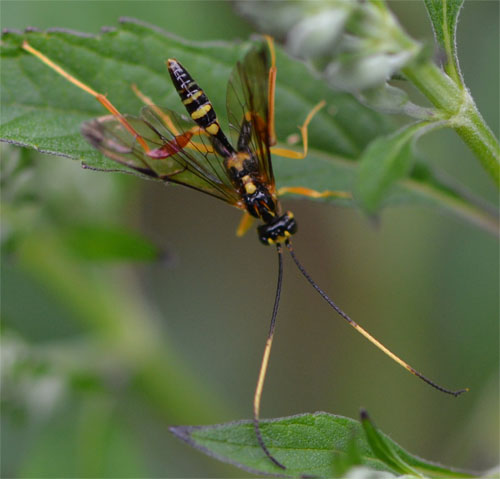
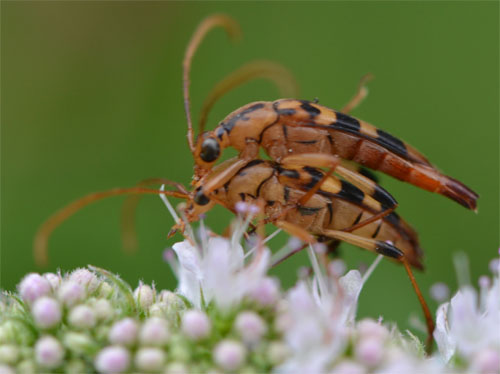
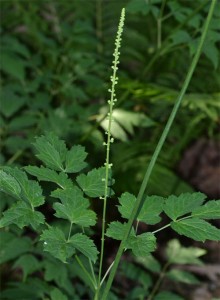 I’ve had bugbane in my woodland garden for a few years now, and while the leaves are beautiful, I had not been overly impressed until this summer. The plants finally matured enough to produce flowers, and they do so in an otherworldly fashion: First these long stalks appear with these slender cornhusk-like appendages. The little bulbeous ornaments on these appendages exploded into white starbursts of flowers about a month ago and they are blooming still, although this will probably end soon. What I was not ready for is the interesting smell of these flowers – It is hard to describe as it seems to fall somewhere between vanilla cookies and mothballs – I find it very different from any other flowers I have smelled. Bees, especially bumble bees, seem to agree as they climb up and down the flowery appendages.
I’ve had bugbane in my woodland garden for a few years now, and while the leaves are beautiful, I had not been overly impressed until this summer. The plants finally matured enough to produce flowers, and they do so in an otherworldly fashion: First these long stalks appear with these slender cornhusk-like appendages. The little bulbeous ornaments on these appendages exploded into white starbursts of flowers about a month ago and they are blooming still, although this will probably end soon. What I was not ready for is the interesting smell of these flowers – It is hard to describe as it seems to fall somewhere between vanilla cookies and mothballs – I find it very different from any other flowers I have smelled. Bees, especially bumble bees, seem to agree as they climb up and down the flowery appendages.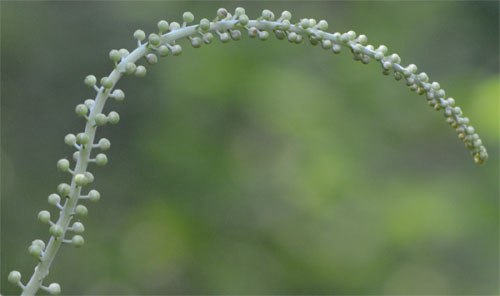
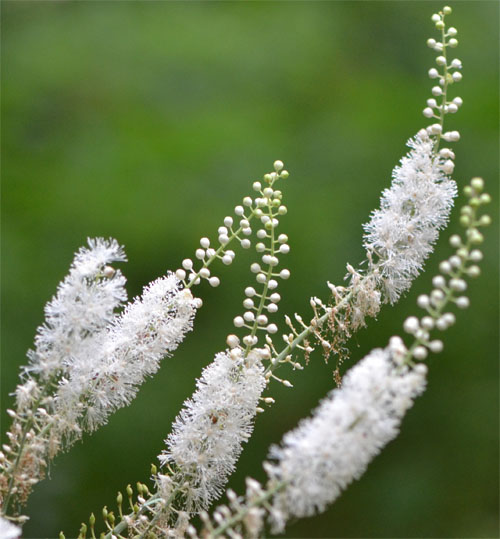
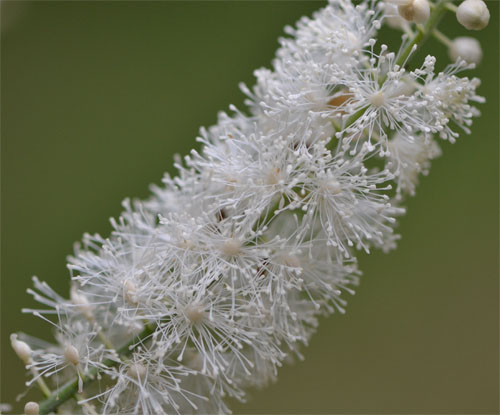
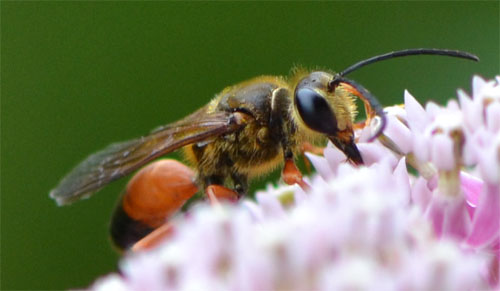
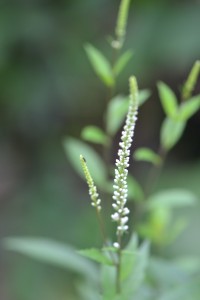 Right now the culver’s root in my yard are cute one-foot-tall plants with beautiful ovate leaves. If they do well over the next few years, however, I should expect these plants to reach 5 or even 6 foot. That is if they tolerate the rather sandy soils – they prefer rich and loamy soil. They are now showing slender 6 to 8 inch spikes of little white flowers, and will probably bloom for a few more weeks. While this makes the plant look like a candelabra, the leaves are where it is at with this perennial – they are a beautiful lighter green and they seem to be unaffected by insects. The joe pye weed right next to it has sustained major leaf damage from leaf chewing or leaf cutting insects, but Veronicastrum virginicum remains untouched.
Right now the culver’s root in my yard are cute one-foot-tall plants with beautiful ovate leaves. If they do well over the next few years, however, I should expect these plants to reach 5 or even 6 foot. That is if they tolerate the rather sandy soils – they prefer rich and loamy soil. They are now showing slender 6 to 8 inch spikes of little white flowers, and will probably bloom for a few more weeks. While this makes the plant look like a candelabra, the leaves are where it is at with this perennial – they are a beautiful lighter green and they seem to be unaffected by insects. The joe pye weed right next to it has sustained major leaf damage from leaf chewing or leaf cutting insects, but Veronicastrum virginicum remains untouched. Sometimes a design is so good or successful that it is worth repeating, often over and over again. Just look at our marine mammals who have adapted over eons, in some form or another, the finlike appendages of fish. However, we are not going to be fooled easily in mistaking one for the other unless you are referring to the Miami Dolphins and their opponents’ fans who yell out “squish the fish” on fall football weekends. When you see a hummingbird moth, you will actually do a double take. My yard has been frequented around the clock by several hummingbirds for a few months now, but I just started seeing Hemaris thysbe, or common clearwing, this week. Their favorite plants to visit are the milkweeds. Since “common clearwing” is not the most descriptive of names, “hummingbird moth” has taken on a life of its own.
Sometimes a design is so good or successful that it is worth repeating, often over and over again. Just look at our marine mammals who have adapted over eons, in some form or another, the finlike appendages of fish. However, we are not going to be fooled easily in mistaking one for the other unless you are referring to the Miami Dolphins and their opponents’ fans who yell out “squish the fish” on fall football weekends. When you see a hummingbird moth, you will actually do a double take. My yard has been frequented around the clock by several hummingbirds for a few months now, but I just started seeing Hemaris thysbe, or common clearwing, this week. Their favorite plants to visit are the milkweeds. Since “common clearwing” is not the most descriptive of names, “hummingbird moth” has taken on a life of its own. 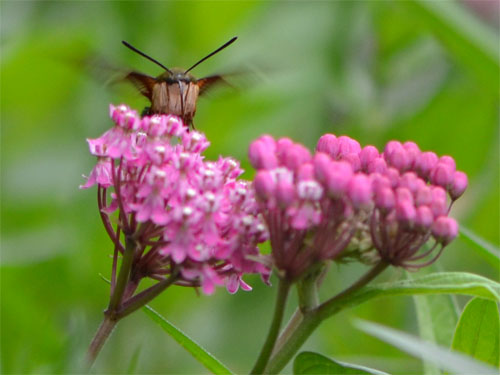
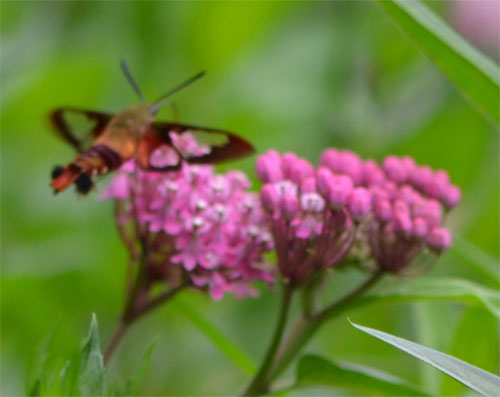
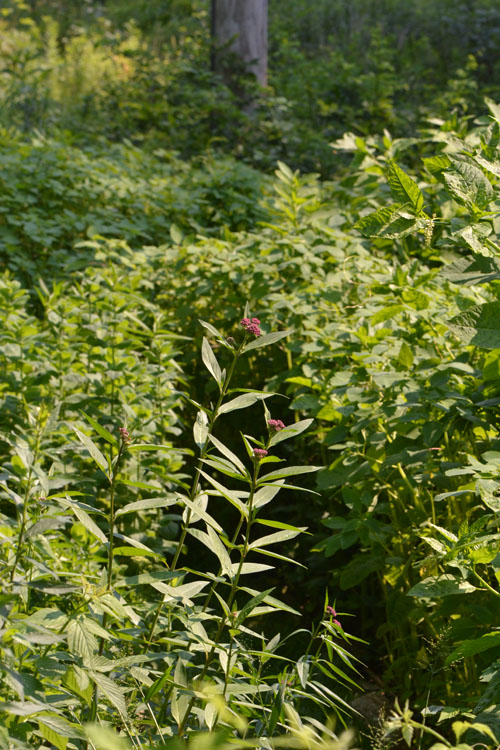
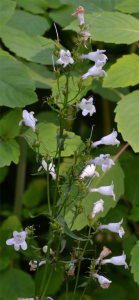 This plant is best suited in a clearing in the woodland garden, since it prefers partial to full sunlight. Foxglove beardtongue has beautiful dark green leaves, but the best features are its long flowering stalks which are over 3 feet tall. The tubular flowers are mostly white but they have faint violet lines which serve as guides to visiting insects. The bumble bees have taken a great liking to Penstemon digitalis, and I have to be somewhat careful walking or working near the plants – they seem a bit more aggressive for they seem to think I’m going to deprive them of the nectar. Foxglove beardtongue is a perennial which will spread from rhizomes, but it also produces a good amount of seed. The stalks will eventually fall over and the seed will be deposited nearby the current plants.
This plant is best suited in a clearing in the woodland garden, since it prefers partial to full sunlight. Foxglove beardtongue has beautiful dark green leaves, but the best features are its long flowering stalks which are over 3 feet tall. The tubular flowers are mostly white but they have faint violet lines which serve as guides to visiting insects. The bumble bees have taken a great liking to Penstemon digitalis, and I have to be somewhat careful walking or working near the plants – they seem a bit more aggressive for they seem to think I’m going to deprive them of the nectar. Foxglove beardtongue is a perennial which will spread from rhizomes, but it also produces a good amount of seed. The stalks will eventually fall over and the seed will be deposited nearby the current plants.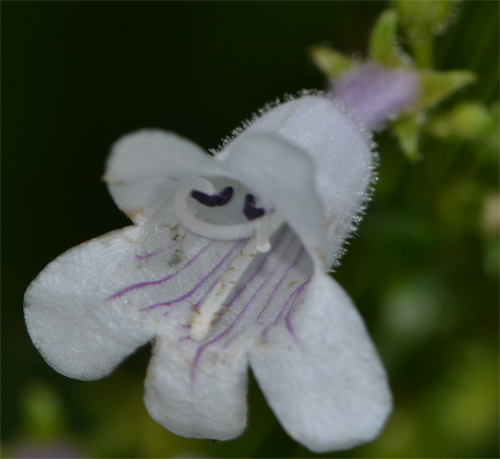
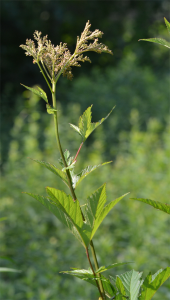
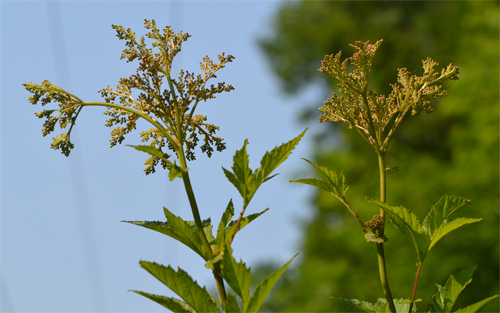
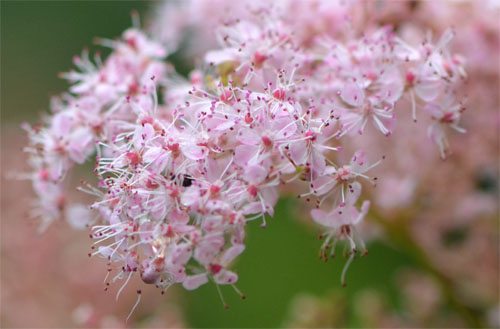
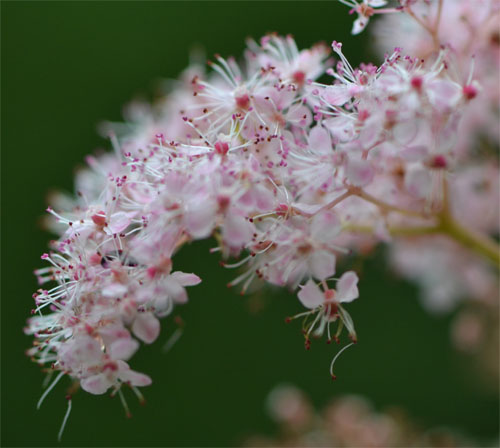
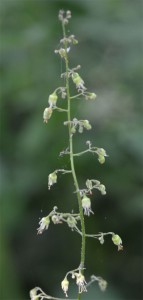 When you see Heuchera sp. (coral bells) in the plant center you usually find cultivars accentuating distinctive leaf features or larger flowering stems. Heuchera americana (coral bells or alumroot) pales somewhat by comparison, but it is still a worthwhile contribution to the woodland garden with its distinctive leaves and spires of greenish-white flowers. This native perennial grows in clumps and does well in somewhat dry conditions, such as can be found in open woodlands. A location with some dappled sunlight in the spring with more persistent shade during the summer is ideal. The heart-shaped basal leaves have 5 to 7 lobes. Longer leaves emerge with a reddish tint but they turn to green later. The small bell shaped flowers are suspended on long stems. The flowers themselves are quite insignificant from a human appreciation perspective but they are important to small bees. The plants in my yard have stems some 15†in height, but apparently they can grow to a height of 3 feet. This makes me think that the plants are currently underperforming in this particular spot. This is their first year however, and I will give them some more time before I consider moving the plants to a potentially more encouraging location.
When you see Heuchera sp. (coral bells) in the plant center you usually find cultivars accentuating distinctive leaf features or larger flowering stems. Heuchera americana (coral bells or alumroot) pales somewhat by comparison, but it is still a worthwhile contribution to the woodland garden with its distinctive leaves and spires of greenish-white flowers. This native perennial grows in clumps and does well in somewhat dry conditions, such as can be found in open woodlands. A location with some dappled sunlight in the spring with more persistent shade during the summer is ideal. The heart-shaped basal leaves have 5 to 7 lobes. Longer leaves emerge with a reddish tint but they turn to green later. The small bell shaped flowers are suspended on long stems. The flowers themselves are quite insignificant from a human appreciation perspective but they are important to small bees. The plants in my yard have stems some 15†in height, but apparently they can grow to a height of 3 feet. This makes me think that the plants are currently underperforming in this particular spot. This is their first year however, and I will give them some more time before I consider moving the plants to a potentially more encouraging location.